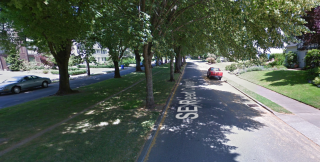
for a neighborhood greenway route, some say.
(Image: Google Street View)
The coalition of neighborhood associations that represents inner Southeast Portland is pushing for some 11th-hour changes that it says would improve the planned 20s Bikeway.
In a letter signed by its president, backed by a 14-2 vote of its board and circulated Wednesday, Southeast Uplift makes three requests of the city.
First, it proposes moving the southernmost leg of the route one block east to Reed College Place south of Tolman Street, avoiding the No. 19 bus line on 32nd Avenue.
Second, it urges the city to keep talking about possible shared space between cars and bikes in the commercial district between Southeast Stark Street and Northeast Sandy Boulevard, something the project manager had committed to but then backed away from as other project costs piled up.
Third, it’s urging the city to reconsider its decision to reject the Concordia Neighborhood Association’s request to add traffic diverters on the new neighborhood greenway north of Alameda Ridge.
Here’s the coalition’s argument for Reed College Place:
SE Reed College Place was originally designed as a recreational corridor, has clear sight-lines for many blocks, intersects other streets at right angles, passes directly next to Dunaway Elementary School, has the most public support and is already being used for recreational purposes. The center median planting strip makes it park like in character, hence by city definition should be, like NE 72nd in Roseway, a city greenway.
Both roadways are designated as Greenways on the 2030 Bike plan, whereas SE 32nd is not. The current choice of 32nd overlaps the 19 bus line, is filled with potholes, has unclear sight-lines and was built with wide curved corners shown to increase speeds and risks to vulnerable users. The neighbors and bicycle riders have expressed concerns that the buses on this narrow lane might pose a serious safety risk.
The one reason PBOT has given for the SE 32nd choice is that some users felt the narrow one lane lanes combined with parking left little room to pull over. As part of the SE Clinton safety project, “Bike may use full lane” signs work to improve safety for this purpose. Placing them to the left in the planted median would make this signage even more robust and alleviate much of these concerns.
Here’s the coalition’s proposed route:
Advertisement
And here’s what Southeast Uplift has to say about the other two items:
The second and third requests apply to the neighborhoods north of Eastmoreland all the way to Concordia. They are about process and the city ignoring promises made. When the central alignment of 29th to 30th was chosen over the 28th avenue bike lane alternative, it was promised to the stakeholders committee that this decision would be revisited after the parking study was completed. This has since occurred. Thus, as a board, we request PBOT reopen this conversation about the shared use commercial environment and potential neighborhood impacts.
Concordia Neighborhood Association voted 19 to 0 for four points of diversion with NE 32nd and NE Prescott being their number one and NE Killingsworth their number two priorities. PBOT promised that they would study this as the project plans moved forward. Instead, the 60% designs were implemented without a public release of the 95% designs for public comment. The rapidity of this process during the winter season gave the neighborhood coalition system very little time to react. As this is a citywide infrastructure project, the board of SE Uplift feels it is critical for PBOT to reopen the conversation surrounding Concordia’s unanimous endorsement, as promised.
The letter is signed by Southeast Uplift President Robert McCullough and by Terry Dublinski-Milton, a Southeast Uplift member at large.
We reported last month that the federally funded 20s Bikeway project has been submitted for federal approval, so it might be difficult to get the city to reopen the process. But that hasn’t changed the frustration of some biking advocates including Dublinski-Milton, who wrote a guest post on BikePortland about the lack of diversion on the northern segment of the route and followed up with a detailed analysis on BikeLoudPDX.org.
As for McCullough, it’s noteworthy that he’s joined forces on this with Dublinski-Milton. Last year, he was opposing removal of parking spaces to create buffered bike lanes on Woodstock Boulevard, arguing that the city needed to do more study of the subject.
— Michael Andersen, (503) 333-7824 – michael@bikeportland.org
BikePortland can’t survive without paid subscribers. Please sign up today.

